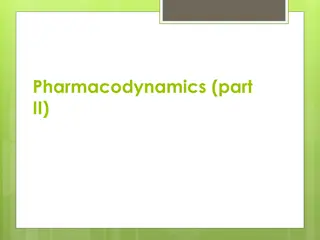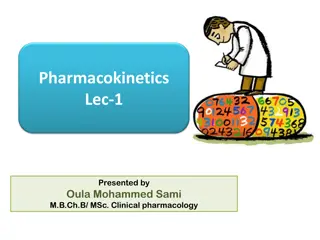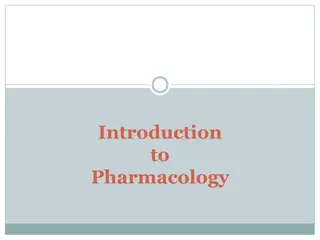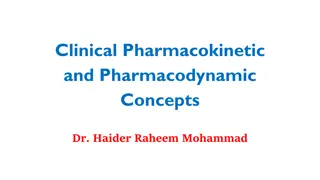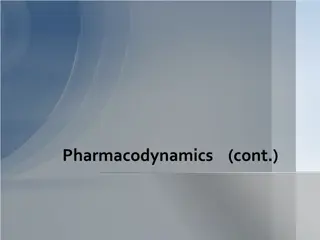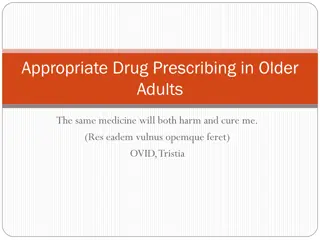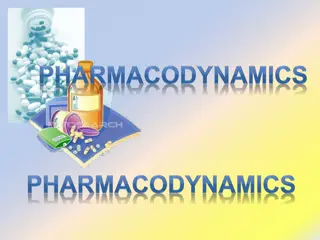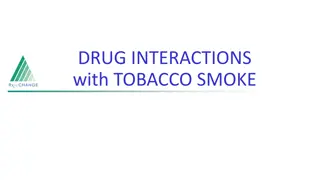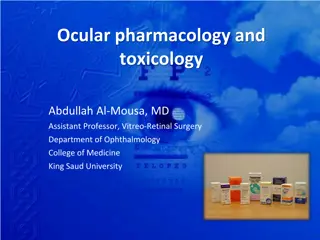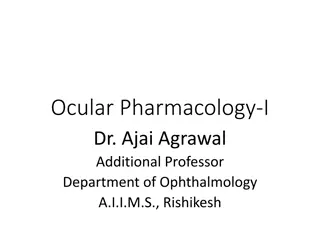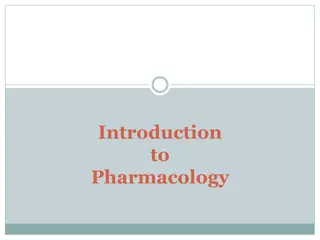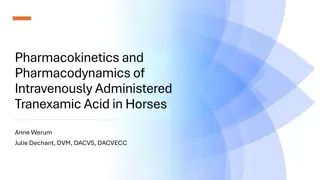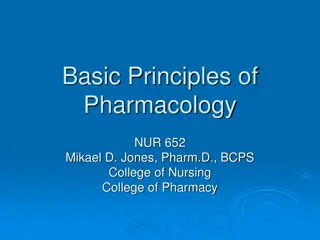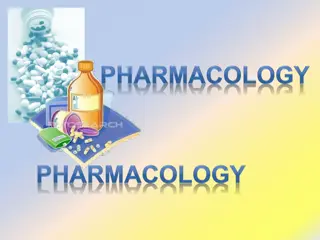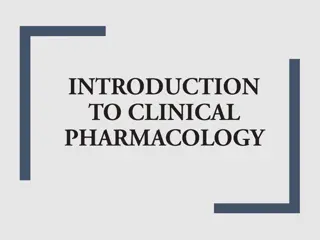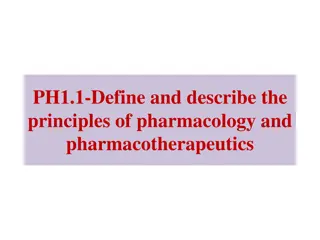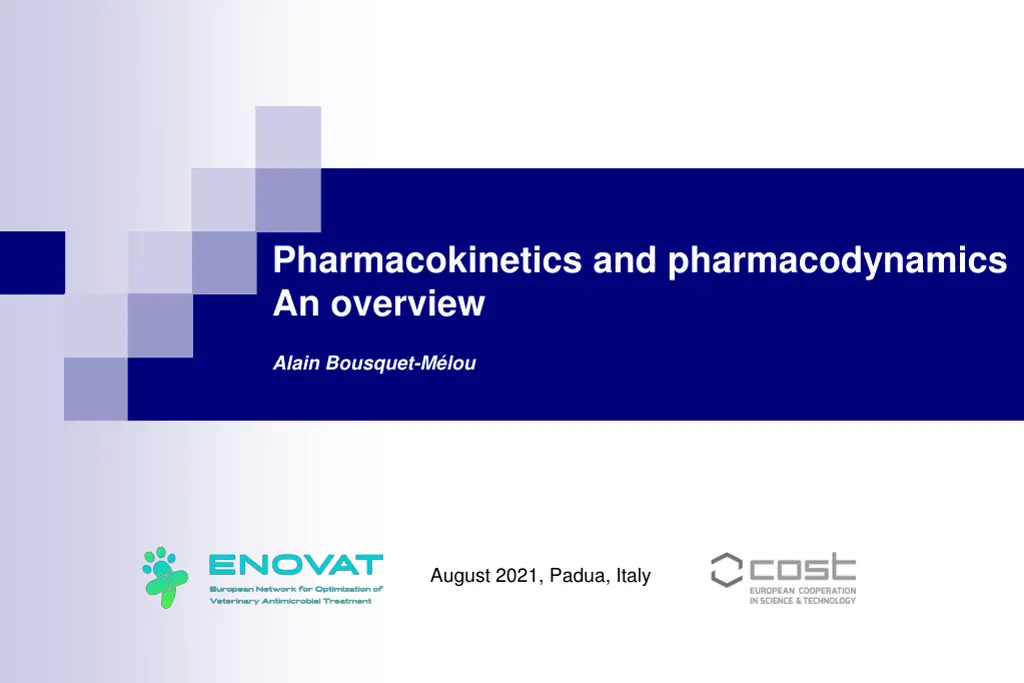
Understanding Pharmacokinetics and Pharmacodynamics
Explore the fundamental concepts of pharmacology, focusing on pharmacokinetics and pharmacodynamics, which study the interactions between drugs and living organisms. Learn about the stages of effect generation, mechanism of action of drugs, and the importance of specificity and selectivity in drug effects.
Download Presentation

Please find below an Image/Link to download the presentation.
The content on the website is provided AS IS for your information and personal use only. It may not be sold, licensed, or shared on other websites without obtaining consent from the author. If you encounter any issues during the download, it is possible that the publisher has removed the file from their server.
You are allowed to download the files provided on this website for personal or commercial use, subject to the condition that they are used lawfully. All files are the property of their respective owners.
The content on the website is provided AS IS for your information and personal use only. It may not be sold, licensed, or shared on other websites without obtaining consent from the author.
E N D
Presentation Transcript
Pharmacokinetics and pharmacodynamics An overview Alain Bousquet-M lou August 2021, Padua, Italy
Pharmacology Pharmacology (pharmacology) Comes from the Greek word "Pharmakon" which means remedy but also poison. The discipline that studies the interactions between drugs and living organisms. This definition covers an extremely broad field since it includes, apart from pharmacokinetics, pharmacodynamics, pharmacovigilance and pharmacodependence, the study of drugs in animals (experimental pharmacology) or in humans (clinical pharmacology). Molecular pharmacology studies the physico-chemical properties of drugs and their relationship with their biological activity. The study of drug use, its context and its consequences for society is the subject of pharmacoepidemiology, pharmacoeconomics and social pharmacology (see these terms).
Pharmacology Pharmacokinetics Pharmacodynamics Action Action of the drug on the body of the body on the drug
The stages of effect generation Dose of active ingredient administered Bacteria Insects Pests Therapeutic response ABSORPTION Interactions Pharmacological Targets Concentrations Blood/plasma Concentrations Biophase DISTRIBUTION ELIMINATION Therapeutic response Cellular action PHARMACOKINETICS PHARMACODYNAMICS
Pharmacokinetics PK is the study of the time development of drug absorption, distribution, metabolism, excretion in relation with pharmacological, therapeutic and toxic responses PK is the study of the organism exposure to the drug and its relationship to the effects of the drug
Pharmacokinetics / Pharmacodynamics Mechanistic aspects Mechanisms of action of drugs Related disciplines: Biochemistry, Physiology Pharmacological targets: receptors, enzymes, etc. The actions at the levels of cells, organs, physiological functions ... Specificity, selectivity: desired effects, secondary effects, adverse effects, etc.
Pharmacokinetics / Pharmacodynamics Mechanistic aspects Mechanisms of action of drugs Related disciplines: Biochemistry, Physiology Pharmacological targets: receptors, enzymes, etc. The actions at the levels of cells, organs, physiological functions ... Specificity, selectivity: desired effects, secondary effects, adverse effects, etc. Mechanisms of drug disposition in the body Related disciplines: Physiology, pharmacy (galenics) ADME: mechanisms of digestive absorption, membrane transport, blood flow, enzymatic metabolism, renal excretion mechanisms, etc. Influence of inter-individual factors and species specificities
Pharmacokinetics / Pharmacodynamics Quantitative aspects At the pharmacodynamic level To link the intensity/magnitude of the effect with the concentration of the active compound : establishment of a concentration-effect relationship Objective: to determine the concentration range (exposure) associated with a given effect
Pharmacokinetics / Pharmacodynamics Quantitative aspects At the pharmacodynamic level To link the intensity/magnitude of the effect with the concentration of the active compound : establishment of a concentration-effect relationship Objective: to determine the concentration range (exposure) associated with a given effect At the pharmacokinetic level To link the amount of active compound administered/ingested with blood and tissue concentrations : establishment of a dose-concentration relationship Objective: to determine the external dose associated with a given exposure
Pharmacokinetics / Pharmacodynamics Quantitative aspects At the pharmacodynamic level To link the intensity/magnitude of the effect with the concentration of the active compound : establishment of a concentration-effect relationship Objective: to determine the concentration range (exposure) associated with a given effect At the pharmacokinetic level To link the amount of active compound administered/ingested with blood and tissue concentrations : establishment of a dose-concentration relationship Objective: to determine the external dose associated with a given exposure Establishment of the Dose-response relationship
Dose-response in a population High Number of subjects Less sensitive (resistant) Individuals More sensitive Individuals Majority of Individuals Medium response Low High Response to the SAME DOSE Low
Dose-exposure-effect relationships Dose Therapeutic response of active ingredient ABSORPTION Biophase ? Concentrations Plasma Concentrations ELIMINATION DISTRIBUTION PHARMACOKINETICS PHARMACODYNAMICS
Dose-exposure-effect relationships Dose Response Black box
Dose-exposure-effect relationships Dose Response Black box Pharmacokinetics Pharmacodynamics Response Dose Concentrations profile
Dose-exposure-effect relationships Dose Response Black box Pharmacokinetics Pharmacodynamics Response Dose Concentrations profile Pharmacokinetic variability / Pharmacodynamic variability To be measured and taken into account: dosage adjustments
PHARMACODYNAMICS Pour simuler diff rents sch mas posologiques, seules les cases soulign es doivent tre modifi es 25 20 0 10 20 14.4 14.4 300 10 20 14.4 14.4 15 Concentration (mg/L) 10 5 0 0 24 48 72 96 120 144 168 192 216 240 264 288 312 336 Temps (h) Exposure Effects
PHARMACODYNAMICS Pour simuler diff rents sch mas posologiques, seules les cases soulign es doivent tre modifi es 25 20 0 10 20 14.4 14.4 300 10 20 14.4 14.4 15 Concentration (mg/L) Threshold Minimal 10 5 0 0 24 48 72 96 120 144 168 192 216 240 264 288 312 336 Temps (h) Exposure Effects
PHARMACODYNAMICS Pour simuler diff rents sch mas posologiques, seules les cases soulign es doivent tre modifi es 25 Threshold Maximal 20 0 10 20 14.4 14.4 300 10 20 14.4 14.4 15 Concentration (mg/L) Threshold Minimal 10 5 0 0 24 48 72 96 120 144 168 192 216 240 264 288 312 336 Temps (h) Exposure Effects
PHARMACODYNAMICS Pour simuler diff rents sch mas posologiques, seules les cases soulign es doivent tre modifi es 25 20 0 10 20 14.4 14.4 300 10 20 14.4 14.4 THERAPEUTIC WINDOW 15 Concentration (mg/L) 10 5 0 0 24 48 72 96 120 144 168 192 216 240 264 288 312 336 Temps (h) Exposure Effects
PHARMACOKINETICS PHARMACODYNAMICS Pour simuler diff rents sch mas posologiques, seules les cases soulign es doivent tre modifi es 25 20 0 10 20 14.4 14.4 300 10 20 14.4 14.4 THERAPEUTIC WINDOW 15 Concentration (mg/L) 10 5 0 0 24 48 72 96 120 144 168 192 216 240 264 288 312 336 Temps (h) Dosage Exposure Effects
PHARMACOKINETICS PHARMACODYNAMICS Pour simuler diff rents sch mas posologiques, seules les cases soulign es doivent tre modifi es 25 20 0 10 20 14.4 14.4 300 10 20 14.4 14.4 THERAPEUTIC WINDOW 15 Concentration (mg/L) 10 Dosage 1 5 0 0 24 48 72 96 120 144 168 192 216 240 264 288 312 336 Temps (h) Dosage Exposure Effects
EXPOSURE PARAMETERS Pour simuler diff rents sch mas posologiques, seules les cases soulign es doivent tre modifi es 25 20 0 10 20 14.4 14.4 300 10 20 14.4 14.4 15 Average concentration Concentration (mg/L) 10 5 0 0 24 48 72 96 120 144 168 192 216 240 264 288 312 336 Temps (h) Area under the concentration curve = AUC
Pharmacokinetic parameters PK parameters Steps 1 - Bioavailability 1 - Absorption 2 Volume of distribution, plasma protein binding 2 - Distribution 3,4 - Clearance 3 - Metabolism 4 - Excretion/Elimination 4 - Half-life
The relationship between pharmacokinetics and pharmacodynamics Elimination capacities Entry into the body Dose = X Target exposure Clearance Bioavailability Dose = X Target AUC
The relationship between pharmacokinetics and pharmacodynamics Clearance Bioavailability Dose per unit time = X Target concentration Properties pharmacodynamics Properties pharmacokinetics
Plasma concentration profiles Intravenous: bolus Conc exponential decay time
Plasma concentration profiles Intravenous: bolus Ln(C) exponential decay elimination time
Plasma concentration profiles Intravenous: bolus Ln(C) distribution + elimination elimination time
Plasma concentration profiles Intravenous: infusion Ln(C) Steady-state concentration Time Duration of infusion
Plasma concentration profiles Extra-vascular route + distribution + elimination absorption Ln(C) distribution + elimination Cmax Cmax elimination Tmax Tmax Time
The decrease in plasma concentrations Terminal half-life
The terminal half-life Definition (1): The time required to halve plasma concentrations ...
The terminal half-life Graphical representation concentrations 100 Log (concentrations) 100 90 80 20 70 10 60 50 40 1 30 20 10 0,1 0 0 20 40 60 80 100 0 20 40 60 80 100 time time T1/2
The terminal half-life Graphical representation Ln(C) distribution + elimination elimination 20 10 time T1/2
The terminal half-life Definition (2): Time to halve plasma concentrations when distribution equilibrium is reached
The terminal half-life Interpretation : The half-life gives information about the rate at which the drug leaves the body Half-life is a "hybrid" parameter that is influenced by distribution and elimination It is descriptive, but not explicative
The terminal half-life Interpretation : ?1/2=?? 2 ? ?? ?????? Distribution Large Low Clearance Half-life Strong Low Identical
The terminal half-life Use : In the case of multiple administration, the value of the terminal half-life provides informations on : - the extent of accumulation of the drug - the importance of fluctuations in concentrations the speed at which the steady state isreached - Its value influences the choice of the dosing interval (one of the criterions of this choice)

